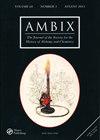De chemist. De geschiedenis van een verdwenen beroepsgroep, 1600–1800
IF 0.3
3区 哲学
Q3 HISTORY & PHILOSOPHY OF SCIENCE
引用次数: 0
Abstract
ground the intersubjectivity of the new science. A few suggestions for further development come to mind. Christian Aristotelians did not think that final causation in non-intelligent things was due to an “indwelling intelligence” (p. 40), but that God directed them to their ends as an archer does an arrow (see Laurence Carlin’s recent work). Similarly, well before Ray, Galen’s De usu partium set out in exhaustive detail how one could make the structures, actions, and uses or functions of body parts into “objects of empirical knowledge” (p. 36). Galen’s texts also separated the descriptions of structures and actions from discussions of their uses (and Galenic anatomy texts often used mundane analogies for parts). Royal Society writers on anatomy almost certainly followed this genre tradition, and not treatises on navigational instruments, as claimed (pp. 93, 202 n. 48). Finally, Aesthetic Science could have found a productive conversation partner in Marieke Hendriksen’s excellent history of the material culture, epistemology, and aesthetics of Leiden’s eighteenth-century anatomical collections, Elegant Anatomy (2015). In sum, this is a beautiful, concise study that will be of interest to historians of science, aesthetics, and communication. The central argument, that aesthetic sensibilities, or at least theories or discourse about them, shaped some investigative and communicative practices in the Royal Society and addressed the problem of intersubjectivity, is striking in its weaving of different sources and fields into a coherent vision.化学家。一个消失的职业的历史,1600 - 1800年
奠定新科学的主体间性。我想到了一些进一步发展的建议。基督教的亚里士多德主义者并不认为非智能事物的最终因果关系是由于“内在的智能”(第40页),而是上帝引导它们走向它们的目标,就像弓箭手引导箭一样(见劳伦斯·卡林最近的作品)。同样,早在雷之前,盖伦的《论通常的部分》就详尽地阐述了一个人如何将身体部位的结构、动作、用途或功能变成“经验知识的对象”(第36页)。盖伦的著作也将结构和动作的描述与用途的讨论分开(盖伦的解剖学著作也经常用普通的类比来描述部分)。英国皇家学会的解剖学作家几乎肯定遵循了这种体裁传统,而不是像声称的那样,写航海仪器的论文(第93页,202页,第48页)。最后,美学科学本可以在Marieke Hendriksen关于莱顿18世纪解剖学收藏的物质文化、认识论和美学的优秀历史中找到一个富有成效的对话伙伴,《优雅的解剖学》(2015)。总而言之,这是一篇优美、简洁的研究,将会引起科学、美学和传播学史学家的兴趣。中心论点是,审美敏感性,或者至少是关于它们的理论或话语,塑造了皇家学会的一些调查和交流实践,并解决了主体间性问题,它将不同的来源和领域编织成一个连贯的愿景,这一点令人震惊。
本文章由计算机程序翻译,如有差异,请以英文原文为准。
求助全文
约1分钟内获得全文
求助全文
来源期刊

Ambix
HISTORY & PHILOSOPHY OF SCIENCE-
CiteScore
0.80
自引率
60.00%
发文量
42
审稿时长
3 months
期刊介绍:
Ambix is an internationally recognised, peer-reviewed quarterly journal devoted to publishing high-quality, original research and book reviews in the intellectual, social and cultural history of alchemy and chemistry. It publishes studies, discussions, and primary sources relevant to the historical experience of all areas related to alchemy and chemistry covering all periods (ancient to modern) and geographical regions. Ambix publishes individual papers, focused thematic sections and larger special issues (either single or double and usually guest-edited). Topics covered by Ambix include, but are not limited to, interactions between alchemy and chemistry and other disciplines; chemical medicine and pharmacy; molecular sciences; practices allied to material, instrumental, institutional and visual cultures; environmental chemistry; the chemical industry; the appearance of alchemy and chemistry within popular culture; biographical and historiographical studies; and the study of issues related to gender, race, and colonial experience within the context of chemistry.
 求助内容:
求助内容: 应助结果提醒方式:
应助结果提醒方式:


